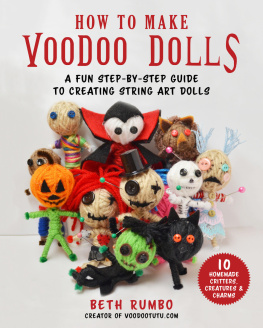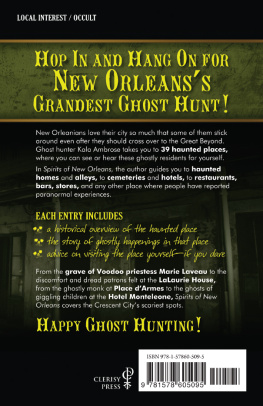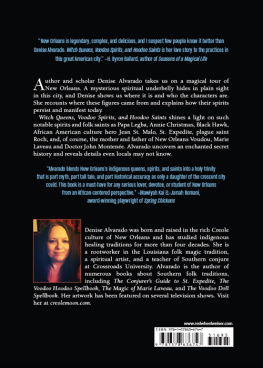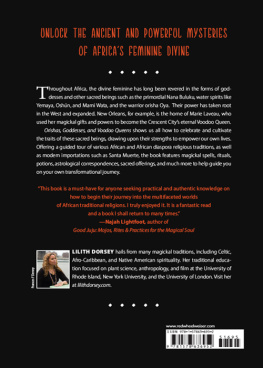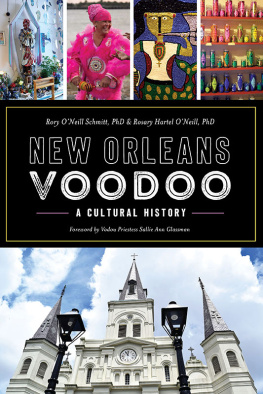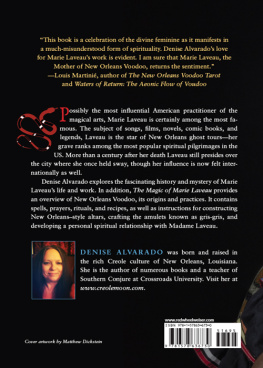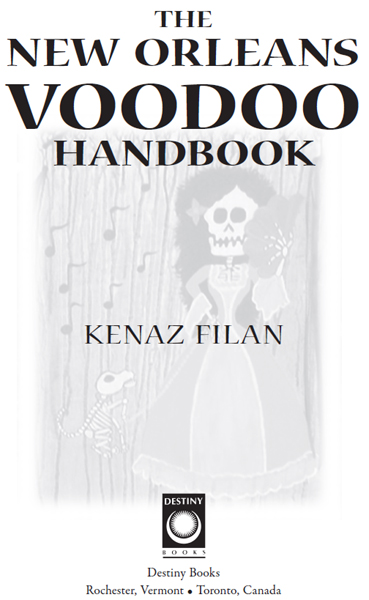
THE NEW ORLEANS VOODOO HANDBOOK

To understand a spiritual practice one must understand both the history and culture in which it flourished. In The New Orleans Voodoo Handbook, Kenaz Filan begins with the critical eye of a historian before investigating New Orleans Voodoo as both a spiritual science and religion. He strips away myth and fallacy, leaving us with fact, and gives us an insiders view of the faiths deepest mysteries. It is the first book Ive read by an experienced houngan dealing with one of the Souths most enduring, powerful legacies. This volume is a welcome addition to both the casual historians and active practitioners library.
OCHANI LELE,
AUTHOR OFDILOGGN TALES OF THE NATURAL WORLD,
TEACHINGS OF THE SATERA GODS, AND
THE DILOGGN: THE ORISHAS, PROVERBS, SACRIFICES, AND
PROHIBITIONS OF CUBAN SANTERA
INTRODUCTION
Many people will tell you that there is no such thing as New Orleans Voodoo. According to them, the whole thing started as a marketing campaign to woo tourists. Later, a few bored white folks created a tradition by reading some books on African and Afro-Caribbean spirituality, then combining that information with African American folk magic, Wicca, hermeticism, and just about anything else they could find that was suitably mysterious and spooky. Those criticisms arent entirely without merit. And yet they miss the greater point: New Orleans Voodoo has become for many a powerful and meaningful religious tradition.
The critics may have a point. There may not have been a survival of Haitian Vodou that persists to the present day in the Louisiana backwoods and bayous. But, like most creation myths, the stories point to a deeper truth. There is something magical in the Crescent City, some force that powers New Orleans Voodoo and that draws people to its holy land for pilgrimages and parties (which have often been closely linked, despite what you may have heard in Sunday school). The explanations may not be literally true, but thats not important. Whats important is that the creation myths point to something that must be explained.
The French philosopher Jean Baudrillard has spoken of simulacrasigns, symbols, and simulations that are treated as and become reality. As he puts it, Simulation... is the generation by models of a real without origin or reality: a hyperreal. The territory no longer precedes the map, nor does it survive it. It is nevertheless the map that precedes the territoryprecession of simulacrathat engenders the territory.
Perhaps the legends created New Orleans Voodoo. If so, that creation has long since taken on a life of its own. The myth has sired many children and has called others to listen and to learn beneath the citys wrought-iron balconies. But many believe something else is behind the stories. They have felt the reality behind the magic; they have drunk from the water of Lake Pontchartrain, and now the city has claimed them for her own.
You may feel her calling out to you in your dreams. You may long for her brightly colored shotgun cottages and the jazz bands playing in her streets. Or you may just be looking for a new spiritual diversion. Your motivations are your own; whatever you want, youll find that New Orleans is happy to oblige you. But be careful. Those who know the city will tell you that theres plenty of danger to go with the beauty. If you dont watch yourself, you may just wind up sucked into something you never bargained for. Shes a sweet mistress, but she can be a harsh one too. Take her joyfully, take her lovingly, but dont you dare take her lightly.
Because, you see, thats the way real magic is. Real magic is as joyful and sad as a jazz funeral, as pretty and as dangerous as white oleander. If you want to experience the spirit world, be ready for beauty that will bring tears to your eyes and for terrors that will scare you witless. Theres plenty of both in New Orleans, and those who will share in her dreams had best be prepared to face her nightmares too. Lots of visitors who overindulged in Bourbon Streets bars have awakened without their wallets and cell phones, and many spiritual tourists who took New Orleans Voodoo for a harmless game found themselves face to face with things they hadnt expected. Those who escaped alive rarely got out unscathed. Like many who came before them, they left with scars as souvenirs of their journey to the Big Easy.
Unlike Haitian Vodou or other more organized Afro-Caribbean traditions, New Orleans Voodoo is a freeform system of worship. You can incorporate whatever works for you into your personal practices, and nobody will tell you that youre doing it wrong. On the other hand, no one is going to tell you that youre doing it right. Like any conjure person, youll have to judge that by how your magic does or does not work. New Orleans Voodoo is not about adherence to a doctrine or a script; its about working with the spirits to bring about changes on the material plane.
For those coming to New Orleans Voodoo from a more structured tradition, this can be simultaneously exhilarating and terrifying. You can declare yourself a conjure man, a root doctor, or a Voodoo Queenbut then youll be expected to deliver the services appropriate to your self-proclaimed title. Youll be judged not by who initiated you or how well you have memorized the proper prayers, but by whether you can do the work for your clients and yourself. If you cant, youre just an empty title, a poor deluded soul pretending to have power youll never have.
I have provided you with introductions to some of the spirits most commonly honored in New Orleans Voodoo, as well as safeguards that may help you to avoid psychic or physical injury. But, in the end, the instructions Ive provided here are merely guidelines. Its up to you to make the acquaintance of the spirits, and its up to you to accept responsibility for the changes they may bring into your lifeand you can rest assured they will bring changes. When you call on the lwas, dont be surprised when they answer.
PART ONE

HISTORY

To understand New Orleans Voodoo, you must first understand the city. New Orleans is a conglomeration of races, classes, and cultures unlike anyplace else in the world. Its terrain, its history, and its people have all contributed to its triumphs and tragedies, and have helped to shape its religious and magical practices.
History should not be treated as a dull collection of names, dates, and events, but as a celebration of the achievements of those who have gone before us. (Besides, only a truly determined historian could make the story of New Orleans boring.) With that in mind, lets pay a joyous, if sometimes somber, tribute to the people who made the Big Easy what it is today.
BORN ON THE BAYOU
The Rise of New Orleans
As the Mississippi flows south from Minnesotas Lake Itasca, it joins with other great streams like the Ohio, the Arkansas, and the Missouri rivers. Each of these brings with it a payload of rich Midwestern soil. By the time the river reaches its mouth, the waters of the Big Muddy are heavy with silt. Flowing into the Gulf of Mexico, it deposits the sediment in the brackish area where salt- and freshwater meet. The result is a fan-shaped landform that resembles the Greek letter D and that is hence called a
Next page

